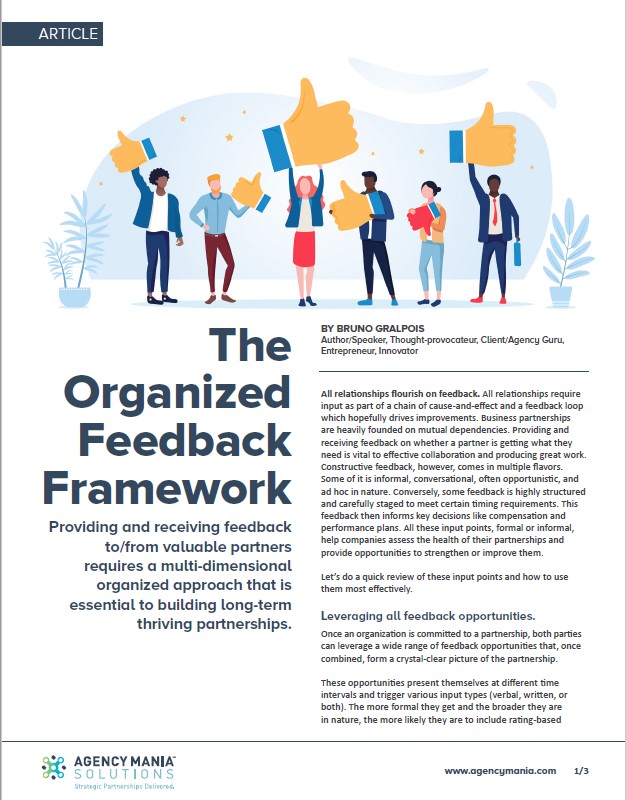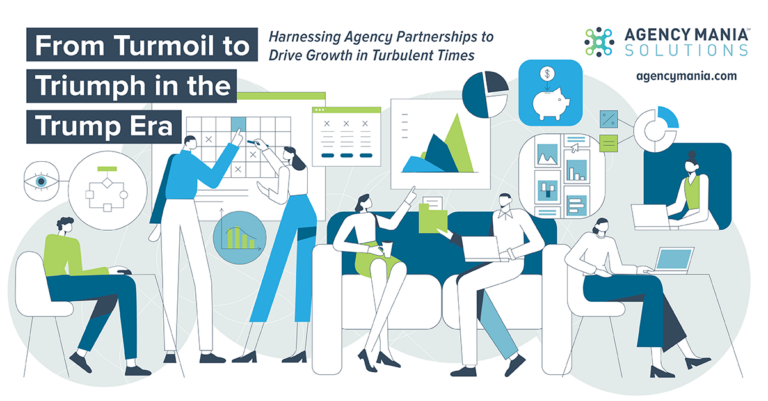Providing and receiving feedback to/from valuable partners requires a multi-dimensional organized approach that is essential to building long-term thriving partnerships:
— Read the published article on 4A’s —
— Read the published article from the Association of National Advertisers–

All relationships flourish on feedback. All relationships require input as part of a chain of cause-and-effect and a feedback loop which hopefully drives improvements. Business partnerships are heavily founded on mutual dependencies. Providing and receiving feedback on whether a partner is getting what they need is vital to effective collaboration and producing great work. Constructive feedback, however, comes in multiple flavors. Some of it is informal, conversational, often opportunistic, and ad hoc in nature. Conversely, some feedback is highly structured and carefully staged to meet certain timing requirements. This feedback then informs key decisions like compensation and performance plans. All these input points, formal or informal, help companies assess the health of their partnerships and provide opportunities to strengthen or improve them.
Let’s do a quick review of these input points and how to use them most effectively.
Leveraging all feedback opportunities.
Once an organization is committed to a partnership, both parties can leverage a wide range of feedback opportunities that, once combined, form a crystal-clear picture of the partnership.
These opportunities present themselves at different time intervals and trigger various input types (verbal, written, or both). The more formal they get and the broader they are in nature, the more likely they are to include rating-based feedback so leadership can monitor progress being made, compare ratings to set targets, and use that data to stack rank agencies, determine bonuses or even inform action plans. Comments are often included to tease out insights and provide additional perspective and recommendations on how to tackle certain relationship and performance issues.

Figure 1: Different types of feedback
Combining feedback inputs for a more cohesive assessment.
The most-used form of feedback assessment is the structured survey-based performance evaluation that takes place annually and, in many cases, at mid-year as well, allowing teams to course correct in a timely manner, instead of waiting for year-end. Ad hoc conversations, check-ins, project postmortems and business reviews are all important input points that should be taken into consideration during this formal performance evaluation process. Participants are asked to incorporate them into their consolidated feedback and scores that otherwise, based on seasonality, may omit some important data points that could be captured throughout the year.
A Yelp-like feedback mechanism in a roster tool allows for additional ratings to be compared to the performance evaluation results and helps draw additional insights otherwise not available. For example, why did an agency get a low performance score at year-end but received consistently good scores throughout the year? Did one of the recent challenging projects they took on overshadowed the great work they did throughout the year and ultimately skew their overall performance assessment?
 Figure 2: How different feedback input points, no matter how formal or structured, contribute to a more holistic assessment of partnerships.
Figure 2: How different feedback input points, no matter how formal or structured, contribute to a more holistic assessment of partnerships.
Constructive feedback for stronger partnerships.
We all receive feedback, from friends, family, peers, bosses, and business partners. If the feedback is fair and balanced, useful, grounded in encouragement, and includes suggestions that contribute to a positive outcome, we are more likely to act upon it. Conversely, feedback that is seen as criticism and offers little hope or insight is largely ignored or disregarded. It fails at driving positive change and discourages people from doing something about the noted issues.
The ability to provide strong, effective, motivating feedback is not a given. This is a skillset that few people have. Yet, the impact on partnerships is critical. Most individuals have never received formal training on how excel at giving constructive feedback that leads to positive change. Companies often provide useful tips or remind employees of techniques they can use to give and receive productive feedback. A structured, organized, and more holistic approach to feedback between brand advertisers and their agencies is the foundation of successful relationship building and more effective partnering. Of course, if you have any constructive feedback about this article, do not hesitate to share!
By Bruno Gralpois, Author/Speaker, Thought-provocateur, Client/Agency Guru, Entrepreneur, Innovator
May 11, 2021









